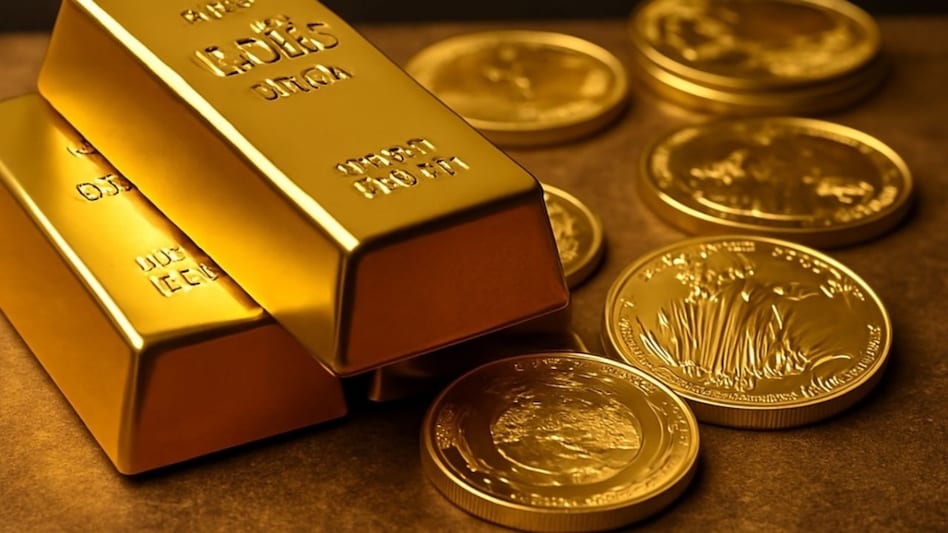 Over the years, gold has not been a consistent performer, particularly when viewed across 5-year return cycles.
Over the years, gold has not been a consistent performer, particularly when viewed across 5-year return cycles.  Over the years, gold has not been a consistent performer, particularly when viewed across 5-year return cycles.
Over the years, gold has not been a consistent performer, particularly when viewed across 5-year return cycles. Gold prices in India have surged to record levels, breaching Rs 93,000 per 10 grams for 24-karat gold, amid a global flight to safety. A mix of geopolitical uncertainty, tariff shocks from the U.S., central bank buying, and expectations of interest rate cuts is fueling this rally. But the question dominating the minds of investors and jewellers alike is: Will gold touch Rs 1 lakh per 10 grams in 2025?
What’s driving the rally?
According to Ryan McIntyre, senior portfolio manager at Sprott Asset Management, central bank purchases and global economic jitters — particularly U.S. President Donald Trump’s aggressive tariff plans — are providing strong upward momentum to gold.
The surge is visible across all categories in India:
24-karat gold: Rs 93,390 per 10 grams
22-karat gold: Rs 85,610 per 10 grams
18-karat gold: Rs 70,050 per 10 grams
(Data: April 11)
Globally, spot gold prices have crossed $3,200 per ounce for the first time, with U.S. gold futures even higher at $3,237.50 per ounce.
Gold has already made 20 all-time highs in 2025 alone, reflecting strong global demand amid fears of recession, currency devaluation, and central bank policy shifts.
Will it reach Rs 1 lakh?
Colin Shah, MD of Kama Jewelry, believes it’s highly probable. He told The Hindu Businessline that with two expected U.S. Fed rate cuts in 2025, gold could very well hit Es 1 lakh per 10 grams. Shah noted that as a safe-haven asset, gold tends to attract higher fund inflows during uncertainty — a pattern that’s playing out now.
Similarly, Kishore Narne of Motilal Oswal sees no upper limit for gold. Speaking to CNBCTV18, he predicted that gold could easily touch $4,000–$4,500 per ounce, saying, “Whatever number you set, it will come eventually.”
Not everyone agrees
Not all experts are convinced that gold will reach the Rs 1 lakh milestone in 2025.
Chintan Mehta, CEO of Abans Financial Services, said that the current rally is likely an extension of the existing trend, rather than the beginning of a new bull cycle. He argued that most bullish catalysts — like rate cut expectations and trade tensions — are already priced in. Without fresh triggers, he believes Rs 1 lakh may not be realistic this year.
Amit Goel, Chief Global Strategist at Pace 360, told CNBC TV18 that the possibility of a medium-term correction in the yellow metal presents an attractive opportunity for long-term investors.
He predicted that gold may retrace over the next six to ten months, potentially reaching around $2,600 per ounce.
In a more significant correction, prices could test the $2,400–$2,500 per ounce range. Nevertheless, Goel remains optimistic about the long-term outlook, pointing to robust structural fundamentals.
Meanwhile, John Mills, strategist at Morningstar, has sounded an even more cautious note. He said a steep drop in gold prices to $1,820 per ounce, implying a potential 38–40% correction from current levels. His bearish thesis is based on rising supply, weakening demand, and potential market saturation.
Should investors increase gold exposure?
As gold prices scale new highs and central banks continue their aggressive buying spree, many retail investors are wondering whether they should follow suit. While gold’s safe-haven status and global demand are undeniable, financial experts caution against making outsized bets on the yellow metal, especially in comparison to equities.
Over the years, gold has not been a consistent performer, particularly when viewed across 5-year return cycles. Its returns have ranged widely — from as low as 1.73% to as high as 17.44%, reflecting significant volatility. In contrast, the Nifty 50 index has delivered relatively stable and consistent returns, with a 5-year performance ranging from 9.67% to 18.78% over the past two decades.
Here’s a snapshot of returns for both asset classes:
Period Gold Nifty 50
1999–2004 7.29% 16.51%
2004–2009 16.87% 9.67%
2009–2014 17.03% 15.75%
2014–2019 1.73% 11.60%
2019–TTM 17.44% 18.78%
Chethan Shenoy, Director & Head – Product & Research at Anand Rathi Wealth Limited, advised maintaining a balanced approach. “It is important to look at the overall portfolio of an investor. We suggest an asset allocation of 80:20 in equity to debt/gold. But overall, gold should not exceed 5–10% of one's portfolio,” he said.
Shenoy added that while gold can serve as a hedge during uncertain times, the risk-adjusted returns of Nifty 50 have consistently outperformed gold, offering better efficiency over time.
Additionally, Indian investors already have a higher allocation to gold than global averages — through jewellery, coins, and other holdings — raising concerns of overexposure in household portfolios.
Still, some market watchers believe that the long-term outlook for gold remains strong, especially given the current macroeconomic backdrop. According to these experts, four key factors could continue to support gold prices:
Escalating trade war tensions
Risk of a U.S. recession
Ongoing geopolitical conflicts in Ukraine and the Middle East
Sustained central bank gold purchases
These conditions, they argue, increase gold’s appeal as a portfolio hedge and could support further upside.
While gold has its merits as a diversification tool and crisis hedge, experts recommend keeping exposure limited. Equities, with their stronger long-term track record and risk-adjusted returns, should remain the core of an investor’s portfolio — with gold playing a supporting role, not a starring one.